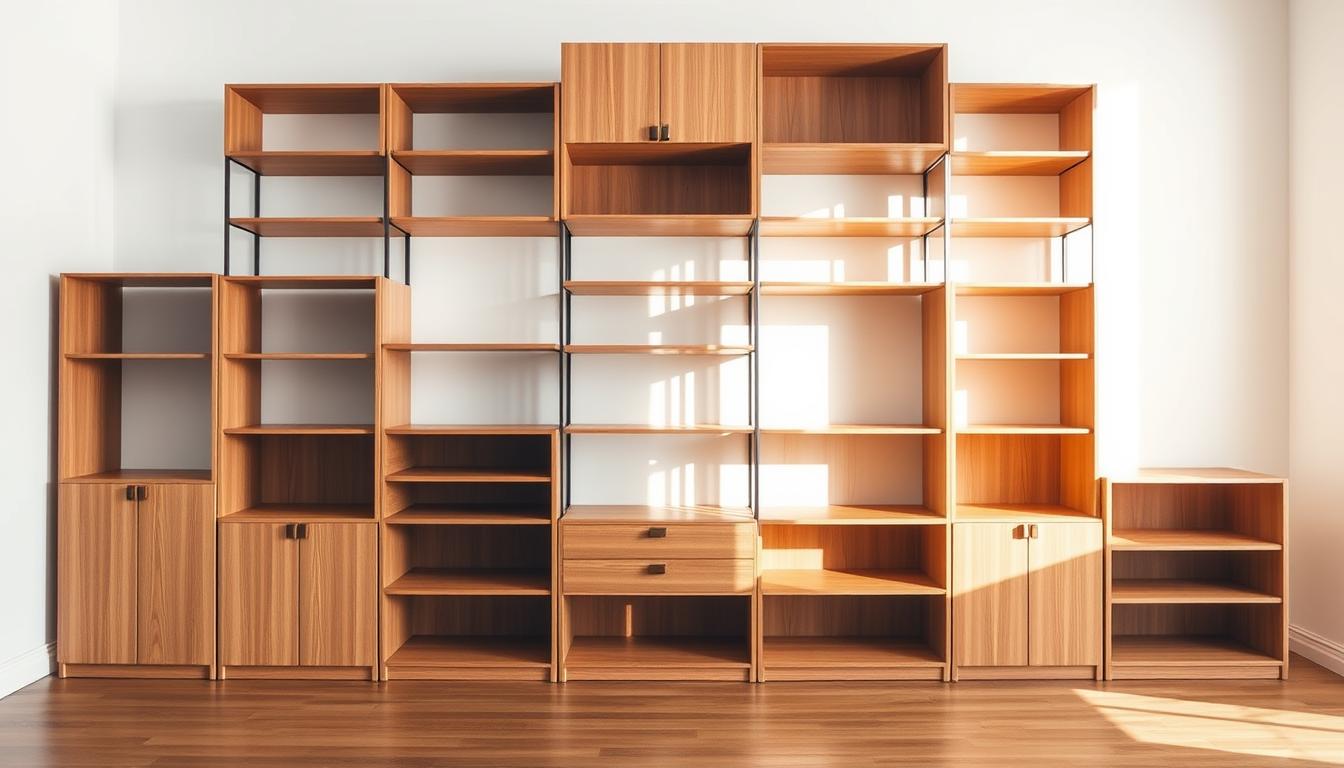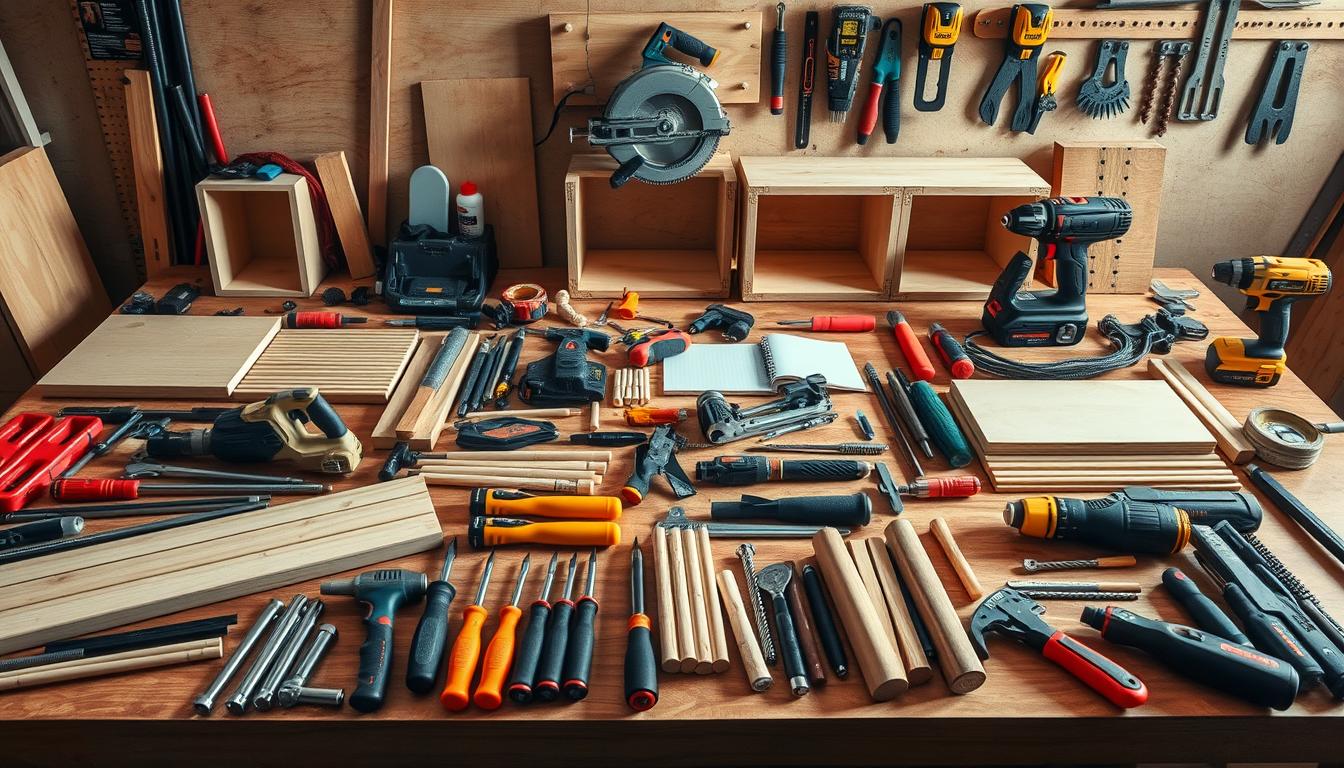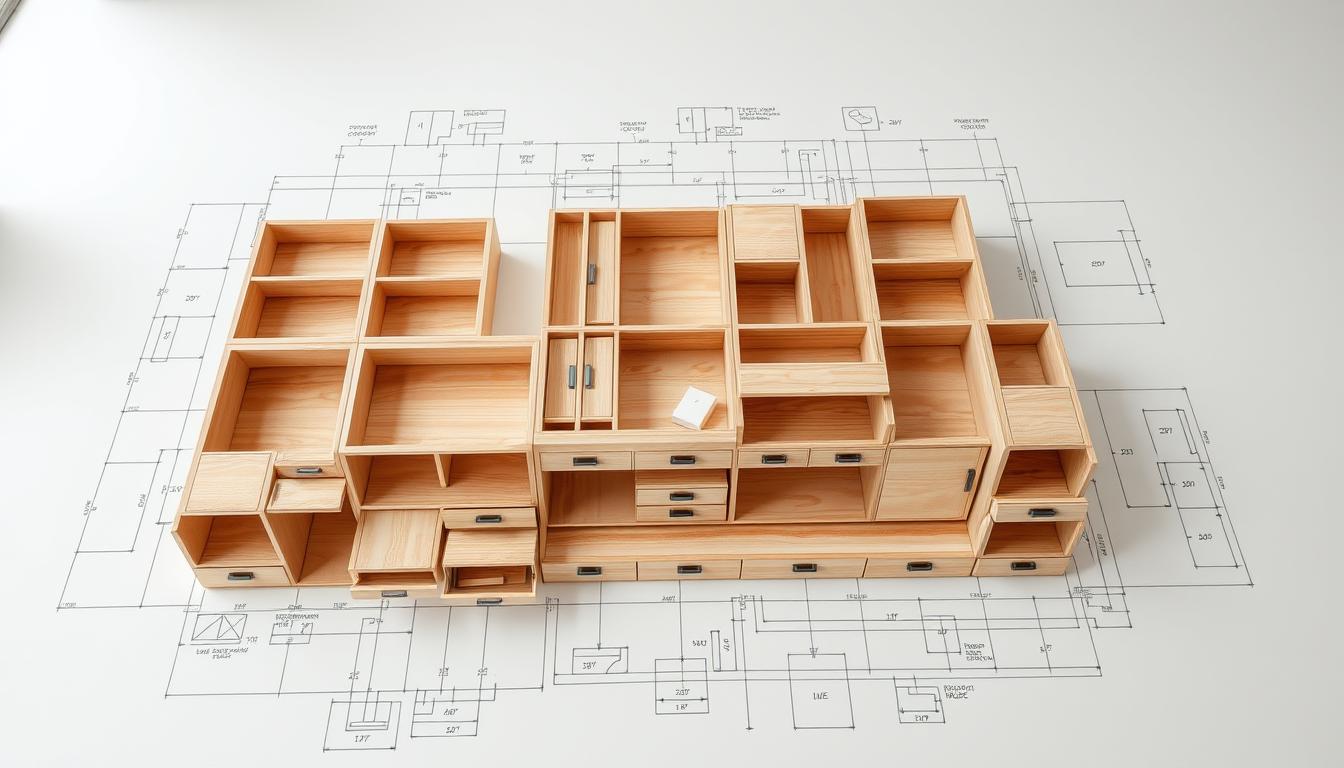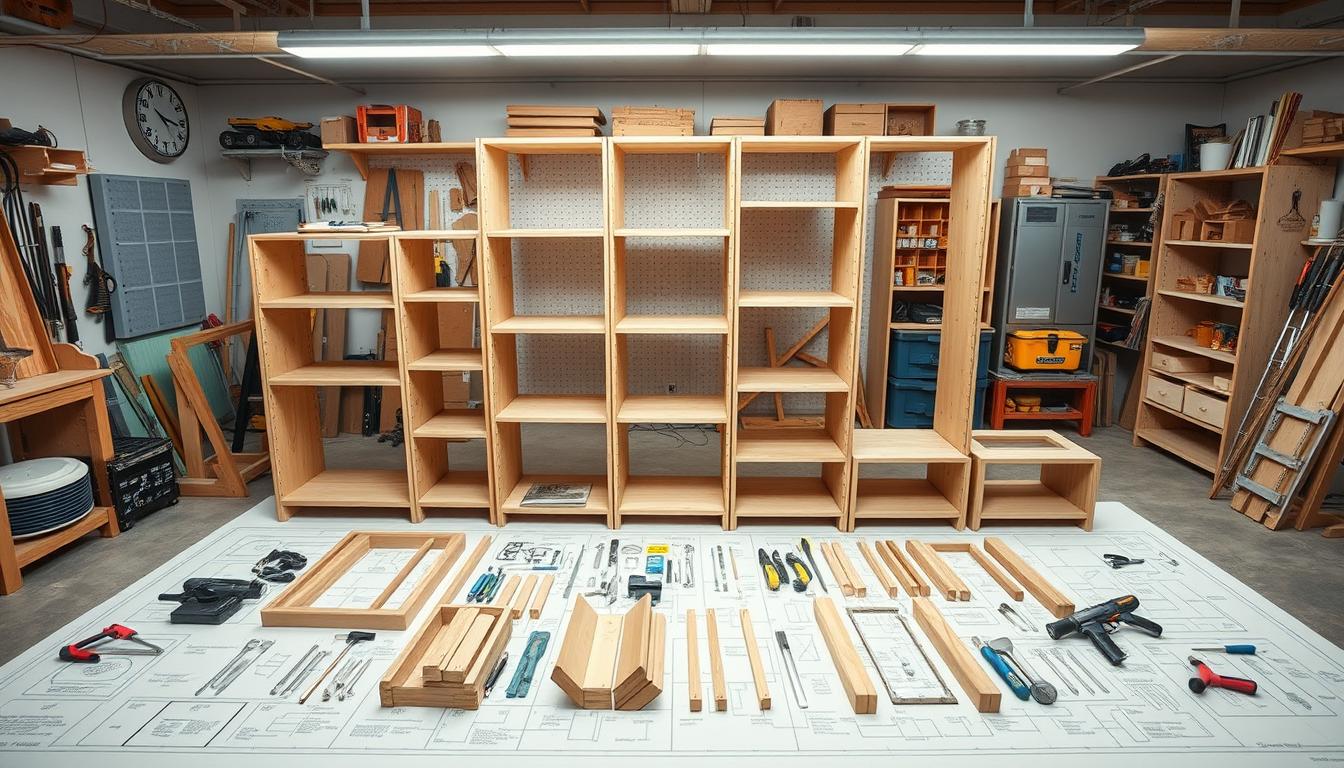Did you know that custom storage solutions can increase the functionality of your space by up to 40%? Whether you’re tackling a cluttered closet or revamping a sunroom, a modular storage system offers unmatched versatility and style. This DIY project allows you to create a tailored solution that fits your exact needs.
Inspired by real-life transformations, this guide draws from systems like ClosetMaid and Elfa. You’ll learn how to design and assemble a high-end look using affordable materials like plywood. With careful planning and the right tools, you can build shelves, desk surfaces, and more to maximize your space.
This project is perfect for DIY enthusiasts ready to take on an intermediate-level challenge. Customize every detail to match your vision, from dimensions to finishes. Ready to get started? Let’s dive into the world of modular storage design.
Key Takeaways
- Custom storage solutions can enhance space functionality by up to 40%.
- Modular systems offer versatility, allowing you to tailor designs to your needs.
- Affordable materials like plywood can create a high-end look.
- Real-life projects inspired by ClosetMaid and Elfa systems.
- Intermediate DIY skills are required for this project.
- Careful planning ensures a seamless and efficient build process.
- Customizable finishes and dimensions make this project uniquely yours.
Project Overview and Benefits of a Modular Storage System
Transform your home with a system that adapts to your changing needs. A modular design allows you to create a tailored solution for any space, whether it’s a living room, study, or play area. Each piece of the system works together to maximize functionality and style.

Understanding the Modular Concept
At its core, a modular storage system is built from individual components that can be rearranged or expanded. Think of it as a puzzle where each shelf or piece fits seamlessly into the overall design. This flexibility lets you reconfigure layouts as your needs evolve.
For example, you might start with a simple setup for books and later add a desk or additional shelves. The ability to customize ensures your system grows with you, making it a long-term investment.
Advantages for Home and Kid-Friendly Storage
Modular systems shine in their versatility. They can be designed to fit along the side or back of a room, creating efficient storage without taking up too much space. For families, these systems are ideal for organizing toys, books, and school supplies.
Safety and accessibility are also key benefits. Each shelf can be secured to prevent tipping, and lower compartments make it easy for kids to reach their belongings. This combination of practicality and design ensures your space stays organized and functional.
“Modular designs offer the perfect balance of flexibility and style, making them a smart choice for any home.”
Here’s a quick comparison of DIY vs. store-bought options:
| Feature | DIY Modular System | Store-Bought System |
|---|---|---|
| Cost | Affordable | Expensive |
| Customization | Fully customizable | Limited options |
| Installation | DIY-friendly | Professional required |
| Durability | High (with quality materials) | Varies by brand |
By choosing a DIY approach, you gain control over every detail, from dimensions to finishes. This ensures your storage system is uniquely yours, blending seamlessly with your home’s aesthetic.
How to Build a Modular Wooden Storage System: Tools, Materials, and Preparation
The foundation of any successful build lies in proper preparation. Gathering the right tools and materials ensures a smooth process and professional results. Whether you’re using advanced equipment like a CNC router or traditional tools like a jigsaw, careful planning is key.

Essential Tools and Equipment
To create a sturdy and functional system, you’ll need a mix of power and manual tools. A circular saw or jigsaw is essential for cutting plywood to size. A hand drill or drill press helps with precise holes for screws and hardware. For assembly, a pocket hole jig ensures clean, professional joints.
Don’t forget safety gear like goggles and gloves. A laser level or measuring tape guarantees accurate layouts. If you’re working with veneer, a hot iron and aluminum foil protectors are must-haves.
Choosing the Right Plywood and Veneer
Selecting the best material is crucial for durability and aesthetics. Birch plywood is a top choice for its strength and smooth finish. It’s ideal for shelves, frames, and other structural components. Ensure the thickness matches your design, typically 12 mm for most projects.
For a polished look, consider applying veneer. Use a hot iron to bond it to the plywood, and protect surfaces with aluminum foil. This step adds a high-end finish without the cost of solid wood.
“Using the right tools and materials not only simplifies the process but also elevates the final result.”
Here’s a quick checklist to prepare for your build:
- Gather all tools and safety equipment.
- Choose high-quality plywood and veneer.
- Pre-paint hardware to save time later.
- Protect surfaces during veneer application.
- Follow safety precautions at every step.
By starting with the right tools and materials, you set yourself up for success. This preparation ensures a seamless build process and a stunning final product.
Designing and Planning Your Custom Storage Unit
Creating a custom storage solution starts with a clear plan and precise measurements. Begin by sketching your layout on paper or using design software. This step ensures every cut and edge aligns perfectly with your vision.

Sketching Your Layout and Measurements
Start by measuring your space and noting any constraints, like wall dimensions or furniture placement. Use a file or template to guide your design. This saves time and ensures accuracy. For example, if you’re planning an overhang for a desk surface, mark it clearly in your sketch.
Next, determine where to next add modifications, like extra compartments or shelves. Planning these details upfront prevents mistakes during assembly. Use a laser level or measuring tape to double-check your measurements.
Customizing Storage for Books, Electronics, and More
Tailor your design to fit specific needs. For books, plan deeper shelves with sturdy supports. For electronics, incorporate cable management holes to keep wires organized. Use veneer to add a polished finish to visible edges.
Consider adding adjustable shelves for versatility. This allows you to reconfigure the unit as your needs change. For example, you might next add a drawer for small items or a cubby for accessories.
“A well-planned design ensures your storage unit fits perfectly into your space, blending functionality with style.”
Finally, plan for drill holes to secure components. Use a template to align them correctly. This step reinforces the structure and ensures stability. By spending time on the design phase, you’ll create a storage solution that’s both practical and visually appealing.
For more tips on precise measurements and layouts, check out this guide on building a riser platform for home. It’s a great resource for ensuring accuracy in your DIY projects.
Assembly Techniques and Construction Tips
Assembling your custom storage solution requires precision and attention to detail. Proper installation ensures stability and durability, while securing components correctly prevents future issues. Let’s explore the techniques that will help you achieve a professional finish.

Proper Installation and Mounting on the Wall
Start by locating wall studs using a stud finder. Mounting your track directly to the studs ensures maximum stability. Use a couple of screws for each stud to secure the rail firmly in place. A laser level helps align the track perfectly, preventing uneven shelves.
For masonry walls without studs, use wall anchors. Drill pilot holes to avoid splitting the material. Countersink hole screws to achieve a flush fit, ensuring a clean and professional look. Always make sure the track is level before proceeding.
Securing Shelves with Brackets, Screws, and Glue
Attach brackets to the rail using screws. Position each shelf carefully, ensuring it’s level and aligned. Use a hand drill to secure the brackets with screws. For added stability, apply wood glue to the joints before tightening the screws.
Check the alignment of each shelf as you go. A bit of patience here ensures a polished final result. Use pictures or diagrams to guide your placement, especially for complex configurations. Always make sure the load is evenly distributed to prevent sagging.
“Proper assembly techniques are the foundation of a durable and functional storage system.”
Here’s a quick comparison of tools for wall mounting:
| Tool | Purpose | Tips |
|---|---|---|
| Stud Finder | Locate wall studs | Use before drilling |
| Laser Level | Align tracks and shelves | Ensure precision |
| Hand Drill | Secure screws | Use pilot holes |
| Countersink Bit | Flush screw placement | Prevents protrusions |
By following these steps, you’ll create a sturdy and reliable storage system. Each bit of effort contributes to a seamless and professional finish.
Enhancing Your Modular Storage System
Elevate your space with creative enhancements that blend functionality and style. Adding finishing touches like veneer and polyurethane finishes not only improves durability but also gives your system a premium look. Whether you’re customizing for a living room or playroom, these modifications ensure your storage solution fits seamlessly into your home.
Creative Finishing Touches and Veneer Application
Transform plain sheets of plywood into elegant surfaces with iron-on veneer. This technique adds a polished wood finish without the cost of solid wood. Use a hot iron to bond the veneer, ensuring smooth edges and a professional look.
For added protection, apply a polyurethane finish. This seals the surface, making it resistant to scratches and spills. It’s especially useful for bottom shelves or surfaces that see heavy use. These finishing touches elevate the visual appeal while maintaining practicality.
Modifications for Versatile Living Room and Playroom Spaces
Maximize every inch of space by adding a bottom shelf that doubles as a desk or media surface. This clever use of floor area ensures your system remains functional and stylish. For playrooms, incorporate decorative boxes as storage compartments, keeping toys and supplies organized.
Adjustable shelves and modular components allow you to reconfigure the design as needs change. For example, add a box for small items or a cubby for accessories. These modifications make the system adaptable to different room types, from cozy playrooms to modern living rooms.
“Creative enhancements not only improve functionality but also add a personal touch to your storage solution.”
Here’s a quick comparison of finishing techniques:
| Technique | Benefits | Best Use |
|---|---|---|
| Iron-On Veneer | Premium wood look | Visible surfaces |
| Polyurethane Finish | Durable protection | High-traffic areas |
| Adjustable Shelves | Versatile storage | Changing needs |
| Decorative Boxes | Stylish organization | Playrooms, living rooms |
By incorporating these enhancements, you’ll create a storage system that’s both practical and visually appealing. Each modification ensures your solution adapts to your lifestyle, making it a long-term investment in your home.
Conclusion
Crafting your own custom solution brings both practicality and creativity to your space. By anchoring your project securely to the wall, you ensure long-term stability and safety. This step is crucial for maintaining a durable and functional setup.
Reflect on the creative options available to tailor your design. Whether you aim for a modern look or a rustic vibe, customization is key. You can build something that not only meets your needs but also enhances your home’s aesthetic.
Despite occasional challenges, every step of the process offers a rewarding outcome. A well-executed DIY project empowers you to transform your space efficiently. Enjoy the blend of functionality and style that your creation delivers.
FAQ
What are the benefits of a modular storage system?
A modular storage system offers flexibility, scalability, and customization. You can adapt it to fit your space, whether for books, electronics, or kid-friendly storage. It’s also easy to expand or rearrange as your needs change.
What tools are essential for building a modular storage system?
You’ll need a saw, drill, screws, brackets, and measuring tools. A pocket hole jig and clamps can also help ensure precise assembly. Having the right tools ensures a smooth construction process.
How do I choose the right plywood and veneer for my project?
Opt for high-quality plywood for durability and stability. Veneer adds a polished finish and can match your decor. Consider the thickness and grain pattern to achieve the desired look and strength.
How do I plan the layout for my custom storage unit?
Start by sketching your design and taking accurate measurements. Consider the items you’ll store, such as books or electronics, and customize the shelves and compartments accordingly. Planning ensures a functional and organized result.
What’s the best way to secure shelves in a modular storage system?
Use brackets, screws, and glue for stability. Ensure shelves are level and properly aligned. For wall-mounted units, anchor them securely to studs for added safety and support.
Can I modify my modular storage system for different spaces?
Yes, modular systems are versatile. You can adjust the design to fit living rooms, playrooms, or even offices. Adding or removing components allows you to tailor the system to your specific needs.
How do I apply veneer for a professional finish?
Cut the veneer to size, apply adhesive evenly, and press it onto the plywood. Use a roller to remove air bubbles and ensure a smooth surface. Trim any excess for a clean, polished look.


